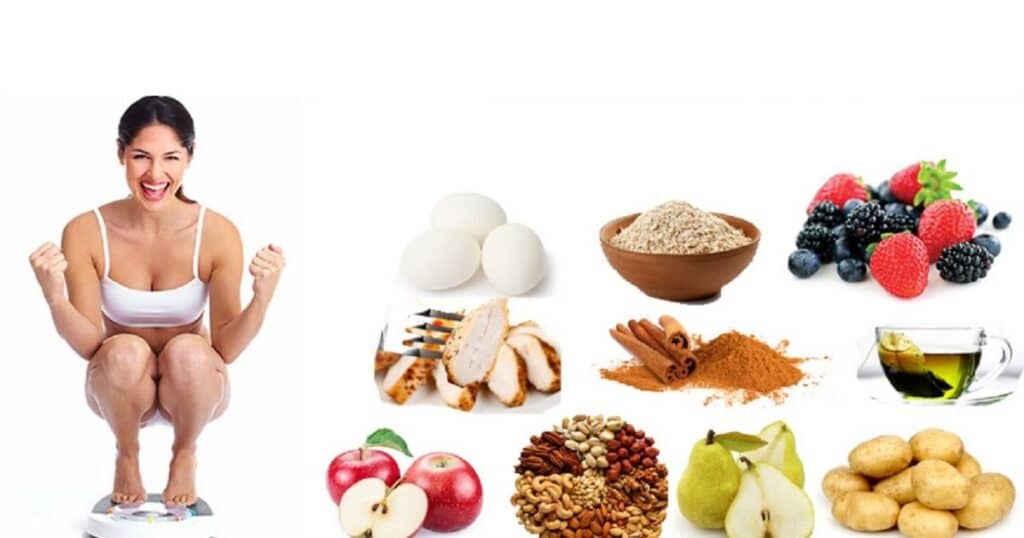Struggling to shed those extra pounds can be a daunting task, but fret not! We’ve compiled a comprehensive guide of 25 proven tips for weight loss that actually work. From simple dietary tweaks to lifestyle changes, these strategies are designed to help you achieve your weight loss goals in a sustainable and effective manner. Whether you’re a novice on the journey to wellness or a seasoned health enthusiast looking for fresh insights, this article has something for everyone. Let’s dive into these practical tips and kickstart your journey towards a healthier, happier you.
An Easy Way To Reduce Fat While Cooking
When it comes to cooking, small changes can make a big difference in your quest for weight loss. Opting for cooking methods that minimize the use of added fats, such as grilling, baking, steaming, or air frying, can significantly reduce your calorie intake without sacrificing flavor.
Instead of drenching your dishes in oil or butter, experiment with herbs, spices, and citrus juices to enhance the taste of your meals without the extra calories. Additionally, investing in quality non-stick cookware can further decrease the need for excessive fats during cooking, making it easier to stick to your weight loss goals.
1. Eat Slowly

In today’s fast-paced world, it’s easy to rush through meals without paying attention to our body’s cues. However, eating slowly and mindfully can be a game-changer when it comes to weight loss. Taking the time to savor each bite allows your brain to register feelings of fullness, preventing overeating and promoting better digestion.
Put down your fork between bites, chew thoroughly, and engage in conversation during meals to slow down your eating pace. Not only will you enjoy your food more, but you’ll also be more in tune with your body’s hunger and satiety signals, leading to more mindful eating habits and sustainable weight loss.
2. Enjoy the Food You Eat
Contrary to popular belief, weight loss doesn’t have to be synonymous with deprivation and bland, boring meals. In fact, one of the most effective strategies for long-term success is to actually enjoy the food you eat. Instead of viewing healthy eating as a chore, embrace it as an opportunity to explore new flavors, ingredients, and culinary techniques.
Experiment with colorful fruits and vegetables, lean proteins, whole grains, and healthy fats to create delicious and satisfying meals that nourish your body and tantalize your taste buds. By finding joy in your food choices, you’ll be more motivated to stick to your healthy eating plan and achieve your weight loss goals with ease.
3. Keep a Daily Gratitude Journal

In the hustle and bustle of everyday life, it’s easy to overlook the importance of gratitude in our journey towards wellness. However, practicing gratitude can have profound effects on both our physical and mental well-being, including aiding in weight loss. Keeping a daily gratitude journal allows you to reflect on the positive aspects of your life, fostering a sense of contentment and fulfillment that can reduce stress and emotional eating.
Take a few moments each day to jot down three things you’re grateful for, whether it’s a delicious meal, a supportive friend, or a beautiful sunset. Cultivating an attitude of gratitude can transform your mindset and help you navigate the ups and downs of your weight loss journey with resilience and grace.
4. Batch Cook and Prep
Meal preparation is key to staying on track with your weight loss goals, and batch cooking is a time-saving strategy that can streamline your healthy eating routine. Set aside some time each week to plan and prepare your meals in advance, chopping vegetables, marinating proteins, and portioning out snacks for easy grab-and-go options throughout the week.
Invest in airtight containers and storage bags to keep your prepped meals fresh and organized, and consider incorporating freezer-friendly recipes that can be reheated quickly for busy days. By taking the guesswork out of mealtime, you’ll be less likely to succumb to unhealthy convenience foods and more likely to stay committed to your weight loss journey.
5. Don’t Forget the Weights
While cardio exercise is often touted as the go-to for weight loss, don’t underestimate the power of strength training in your fitness routine. Incorporating resistance exercises, such as lifting weights or using resistance bands, can help build lean muscle mass, which in turn boosts your metabolism and aids in fat loss. Aim to include at least two to three strength training sessions per week, targeting all major muscle groups for a balanced and effective workout.
Not only will you burn calories during your strength training sessions, but you’ll also continue to torch calories post-workout as your body repairs and rebuilds muscle tissue. Plus, the added strength and definition you’ll gain can enhance your overall physique and boost your confidence as you progress on your weight loss journey.
6. Get Enough Z’s

Quality sleep is often overlooked but is essential for overall health and well-being, including weight management. Lack of sleep can disrupt hormone levels, particularly those that regulate hunger and appetite, leading to increased cravings and overeating. Aim for seven to nine hours of uninterrupted sleep each night to support your weight loss efforts and promote optimal physical and mental functioning.
Establish a relaxing bedtime routine, such as dimming the lights, avoiding screens, and practicing relaxation techniques like deep breathing or meditation, to signal to your body that it’s time to wind down. By prioritizing sleep, you’ll not only feel more energized and focused during the day but also better equipped to make healthy choices that align with your weight loss goals.
7. Don’t Skip Meals
Skipping meals in an attempt to save calories can actually backfire and sabotage your weight loss efforts in the long run. When you skip meals, your body goes into survival mode, slowing down your metabolism and conserving energy stores to compensate for the lack of fuel. This can lead to increased hunger and cravings later in the day, making it more likely that you’ll overeat or reach for unhealthy snacks to satisfy your cravings.
Instead of skipping meals, focus on creating balanced, nutrient-dense meals and snacks that provide sustained energy and keep you feeling satisfied throughout the day. Aim to eat every three to four hours to keep your metabolism revved up and your hunger in check, making it easier to stick to your calorie goals and achieve long-term weight loss success.
8. Stay Hydrated
Proper hydration is essential for overall health and well-being, but it’s also a crucial component of any successful weight loss plan. Drinking an adequate amount of water throughout the day can help curb appetite, boost metabolism, and promote feelings of fullness, making it easier to control portion sizes and resist overeating. Aim to drink at least eight glasses of water per day, and consider sipping on herbal teas or flavored water for added hydration and variety.
Keep a reusable water bottle with you at all times to remind yourself to drink regularly, and pay attention to your body’s thirst cues to ensure you’re staying adequately hydrated. By prioritizing hydration, you’ll not only support your weight loss efforts but also promote overall health and well-being for a happier, healthier you.
9. Cut Calories, Not Flavor
Contrary to popular belief, healthy eating doesn’t have to be bland or boring. With a few simple swaps and substitutions, you can cut calories without sacrificing flavor or satisfaction. Experiment with herbs, spices, and condiments to add depth and complexity to your meals, and focus on incorporating plenty of flavorful ingredients like garlic, onions, citrus, and fresh herbs.
Choose lean proteins, whole grains, and plenty of fruits and vegetables to bulk up your meals without adding extra calories, and opt for cooking methods like grilling, roasting, or steaming to maximize flavor without excess fat. By focusing on the quality and variety of your food choices, you can create delicious and satisfying meals that support your weight loss goals and keep you motivated on your journey to better health.
10. Reorganize Your Plate

The composition of your meals can have a significant impact on your weight loss success, so take a closer look at what’s on your plate and make some strategic swaps to support your goals. Aim to fill half of your plate with non-starchy vegetables, such as leafy greens, broccoli, cauliflower, and peppers, to increase fiber and volume without adding extra calories. Reserve a quarter of your plate for lean proteins, such as chicken, fish, tofu, or beans, to help build and repair muscle tissue and promote feelings of fullness.
Finally, dedicate the remaining quarter of your plate to whole grains or starchy vegetables, such as brown rice, quinoa, sweet potatoes, or whole grain pasta, to provide sustained energy and fuel your body for activity. By reorganizing your plate in this way, you’ll create balanced, satisfying meals that support your weight loss goals and keep you feeling full and energized throughout the day.
11. Start Where You Are and Do What You Can
Embarking on a weight loss journey can feel overwhelming, but remember that every small step counts towards progress. Instead of focusing on how far you have to go, start where you are and do what you can with the resources and knowledge you have. Set realistic, achievable goals for yourself, whether it’s drinking an extra glass of water each day, taking the stairs instead of the elevator, or adding an extra serving of vegetables to your meals.
Celebrate your successes along the way, no matter how small, and don’t be too hard on yourself if you slip up occasionally. By taking consistent action and staying committed to your goals, you’ll gradually build momentum and make meaningful progress towards a healthier, happier you.
12. Think Big — Not Small
When it comes to weight loss, it’s important to think beyond just the number on the scale and focus on the bigger picture of overall health and well-being. Instead of fixating on short-term results or quick fixes, adopt a long-term mindset that prioritizes sustainable lifestyle changes and habits. Shift your focus from simply losing weight to improving your overall health and quality of life, whether it’s increasing your energy levels, reducing your risk of chronic disease, or improving your confidence and self-esteem.
By setting meaningful, holistic goals that align with your values and priorities, you’ll be more motivated to stay on track and make lasting changes that contribute to your overall health and happiness.
13. Look Beyond the Scale
While tracking your progress on the scale can be a useful tool for monitoring weight loss, it’s important to remember that it’s not the only measure of success. Instead of fixating on the numbers, pay attention to other indicators of progress and well-being, such as how your clothes fit, changes in your body composition, improvements in your fitness level, or enhancements in your mood and energy levels.
Celebrate non-scale victories along the way, whether it’s running a faster mile, fitting into a smaller clothing size, or simply feeling more confident and comfortable in your own skin. By broadening your definition of success and focusing on the positive changes you’re experiencing, you’ll stay motivated and inspired to continue your journey towards better health and happiness.
14. Give Your Breakfast a Protein Boost

Starting your day with a protein-rich breakfast can set the tone for healthy eating habits and sustained energy throughout the day. Protein helps keep you feeling full and satisfied, reducing the likelihood of overeating later in the day and stabilizing blood sugar levels to prevent energy crashes. Aim to include a source of protein in your morning meal, such as eggs, Greek yogurt, cottage cheese, tofu, or protein powder, along with fiber-rich carbohydrates like whole grains, fruits, and vegetables for a balanced and satisfying start to your day.
Experiment with different breakfast options to find what works best for you, whether it’s a hearty omelet, a protein smoothie, or overnight oats topped with nuts and seeds. By prioritizing protein at breakfast, you’ll kickstart your metabolism, curb cravings, and fuel your body for a productive day ahead.
15. In Fact, Consume Protein at Every Meal
While breakfast is often touted as the most important meal of the day, it’s equally important to include protein in every meal and snack to support your weight loss goals. Protein helps preserve lean muscle mass, which is essential for a healthy metabolism and overall body composition, and promotes feelings of fullness and satiety to prevent overeating. Aim to include a source of protein in each meal and snack, whether it’s lean meats, poultry, fish, eggs, dairy products, tofu, tempeh, legumes, or protein-rich grains like quinoa and amaranth.
Pair your protein with fiber-rich carbohydrates and healthy fats to create balanced, satisfying meals that keep you fueled and satisfied throughout the day. By prioritizing protein at every meal, you’ll support your weight loss efforts, maintain muscle mass, and feel more satisfied and energized throughout the day.
16. Try to Eat Mainly Whole, Minimally Processed Foods
When it comes to weight loss, the quality of your food choices matters just as much as the quantity. Focus on eating mainly whole, minimally processed foods that are rich in nutrients and free from added sugars, unhealthy fats, and artificial additives. Choose fresh fruits and vegetables, lean proteins, whole grains, nuts, seeds, and legumes as the foundation of your diet, and limit your intake of packaged and processed foods like sugary snacks, processed meats, refined grains, and convenience foods.
Not only are whole foods more nutritious and satisfying, but they also tend to be lower in calories and higher in fiber, which can support weight loss and promote overall health. By prioritizing whole, minimally processed foods, you’ll nourish your body with the nutrients it needs to thrive and achieve your weight loss goals more effectively.
17. Limit High-Glycemic Carbohydrate Foods

High-glycemic carbohydrate foods, such as refined grains, sugary snacks, and sweetened beverages, can cause rapid spikes and crashes in blood sugar levels, leading to increased hunger, cravings, and fluctuations in energy levels. To support your weight loss goals and stabilize blood sugar levels, aim to limit your intake of high-glycemic carbohydrate foods and focus on choosing lower glycemic options instead.
Opt for whole grains like brown rice, quinoa, barley, and oats, which are rich in fiber and nutrients and have a slower impact on blood sugar levels. Include plenty of non-starchy vegetables, fruits, and legumes in your diet to add bulk and volume without the added sugar and empty calories. By prioritizing low-glycemic carbohydrate foods, you’ll promote steady energy levels, reduce cravings, and support sustainable weight loss without feeling deprived or hungry.
18. Experiment With Fruits at Dessert Time
Satisfying your sweet tooth doesn’t have to derail your weight loss efforts—simply swap out sugary desserts for naturally sweet fruits to satisfy your cravings without the added calories and guilt. Experiment with a variety of fruits, such as berries, melons, citrus fruits, apples, and pears, to create delicious and satisfying desserts that are both nutritious and indulgent. Enjoy a bowl of mixed berries with a dollop of Greek yogurt and a drizzle of honey, or try slicing up a juicy mango or pineapple for a refreshing and tropical treat.
Get creative in the kitchen and incorporate fruits into your favorite dessert recipes, such as fruit salads, smoothie bowls, fruit crisps, or homemade sorbets. By choosing fruits as your dessert of choice, you’ll satisfy your sweet cravings while nourishing your body with essential vitamins, minerals, and antioxidants for optimal health and well-being.
19. Eat Breakfast Like a King, Lunch Like a Prince, and Dinner Like a Pauper
The timing and composition of your meals can have a significant impact on your weight loss success, so consider adopting the old adage of “eating breakfast like a king, lunch like a prince, and dinner like a pauper” to support your goals. Start your day with a hearty and balanced breakfast that includes a mix of protein, fiber, and healthy fats to fuel your body and jumpstart your metabolism. For lunch, aim for a satisfying and nutritious meal that keeps you energized and focused throughout the afternoon without weighing you down.
Finally, opt for a lighter and earlier dinner that focuses on lean proteins, vegetables, and whole grains to prevent overeating and support digestion before bedtime. By aligning your meals with your body’s natural rhythms and energy needs, you’ll optimize your metabolism, balance your hunger hormones, and support sustainable weight loss over time.
20. Get Into Meal Planning
Meal planning is a powerful tool for weight loss success, helping you stay organized, save time and money, and make healthier food choices throughout the week. Set aside some time each week to plan out your meals and snacks, taking into account your schedule, dietary preferences, and calorie goals. Start by brainstorming meal ideas and recipes, making a shopping list of ingredients, and prepping ingredients and meals in advance to streamline your weeknight dinners and busy mornings.
Consider batch cooking large batches of staples like grains, proteins, and vegetables to mix and match into different meals throughout the week, or invest in meal delivery services or pre-made meal kits for added convenience. By making meal planning a regular part of your routine, you’ll set yourself up for success and make it easier to stick to your weight loss goals with minimal stress and effort.
21. Make a Grocery List and Stick to It

One of the most effective strategies for staying on track with your weight loss goals is to make a grocery list and stick to it when shopping. Before heading to the store, take inventory of your pantry, fridge, and freezer, and make a list of items you need to stock up on for the week ahead. Focus on filling your cart with nutrient-dense, whole foods like fruits, vegetables, lean proteins, whole grains, and healthy fats, and avoid impulse purchases of processed snacks, sugary treats, and convenience foods.
Consider shopping the perimeter of the grocery store, where fresh produce, dairy, and protein options are typically located, and limit your time in the center aisles where processed and packaged foods are more prevalent. By planning ahead and sticking to your grocery list, you’ll ensure that your home is stocked with healthy options that support your weight loss goals and make it easier to make nutritious choices throughout the week.
22. Take Stock of What’s in Your Kitchen
Your kitchen environment can have a significant impact on your eating habits and weight loss success, so take some time to assess what’s in your pantry, fridge, and freezer and make adjustments as needed. Start by clearing out any tempting or trigger foods that may derail your progress, such as sugary snacks, processed treats, and unhealthy convenience foods. Replace these items with nutritious alternatives like fresh fruits and vegetables, lean proteins, whole grains, and healthy fats that support your weight loss goals and align with your dietary preferences.
Organize your kitchen space to make healthy choices more accessible and convenient, such as placing fresh produce front and center in the fridge or keeping pre-portioned snacks on hand for easy grab-and-go options. By taking stock of what’s in your kitchen and making intentional choices about what you keep on hand, you’ll create a supportive environment that sets you up for success on your weight loss journey.
23. Have the Right Tools on Hand
Having the right tools and equipment in your kitchen can make healthy eating and meal preparation much easier and more enjoyable. Invest in quality kitchen gadgets and appliances like a sharp chef’s knife, cutting board, blender, food processor, and slow cooker to streamline meal prep and cooking processes. Stock up on storage containers, meal prep containers, and reusable bags to portion out meals and snacks in advance and keep them fresh and organized throughout the week.
Consider investing in a kitchen scale or measuring cups and spoons to accurately portion out ingredients and track your servings for better portion control. By having the right tools on hand, you’ll make it easier to stick to your weight loss goals and create delicious, nutritious meals that support your health and well-being.
24. Read Food Labels

When it comes to making informed food choices, reading food labels is essential for identifying hidden sugars, unhealthy fats, and artificial additives that can sabotage your weight loss efforts. Take the time to read the nutrition facts panel and ingredient list on packaged foods to assess their nutritional value and make informed decisions about what to include in your diet. Pay attention to serving sizes, calorie counts, and nutrient content, and be wary of products that are high in added sugars, sodium, and unhealthy fats.
Look for whole food ingredients that you recognize and can pronounce, and choose products that are low in processed ingredients and artificial additives. By becoming a savvy label reader, you’ll empower yourself to make healthier choices that support your weight loss goals and overall well-being.
25. Choose Super Snacks
Snacking can be a valuable tool for weight loss success, providing an opportunity to fuel your body between meals and prevent excessive hunger and overeating. However, not all snacks are created equal, so choose super snacks that are both satisfying and nutritious to support your weight loss goals. Opt for snacks that provide a balance of protein, fiber, and healthy fats to keep you feeling full and satisfied, such as Greek yogurt with berries, apple slices with almond butter, or veggie sticks with hummus.
Avoid sugary snacks and processed treats that are high in empty calories and provide little nutritional value, and instead focus on whole food options that nourish your body and support your health and well-being. By choosing super snacks that satisfy your cravings and provide sustained energy, you’ll stay on track with your weight loss goals and feel great throughout the day.
Conclusion
In conclusion, achieving and maintaining a healthy weight is a journey that requires commitment, patience, and perseverance. By incorporating these 25 tips for weight loss into your daily routine, you’ll be well-equipped to overcome obstacles, stay motivated, and achieve lasting success. Remember that small changes can add up to big results over time, so focus on making sustainable lifestyle changes that align with your goals and values.
Whether it’s cooking more meals at home, prioritizing protein at every meal, or practicing gratitude and mindfulness, every step you take towards better health is a step in the right direction. With dedication and determination, you can transform your body, mind, and life and become the healthiest, happiest version of yourself.

Bookish Bard, known as Weightloss, boasts 8 years of expertise in the field. A seasoned author, Weightloss combines literary prowess with extensive knowledge, crafting insightful works that inspire and inform.











